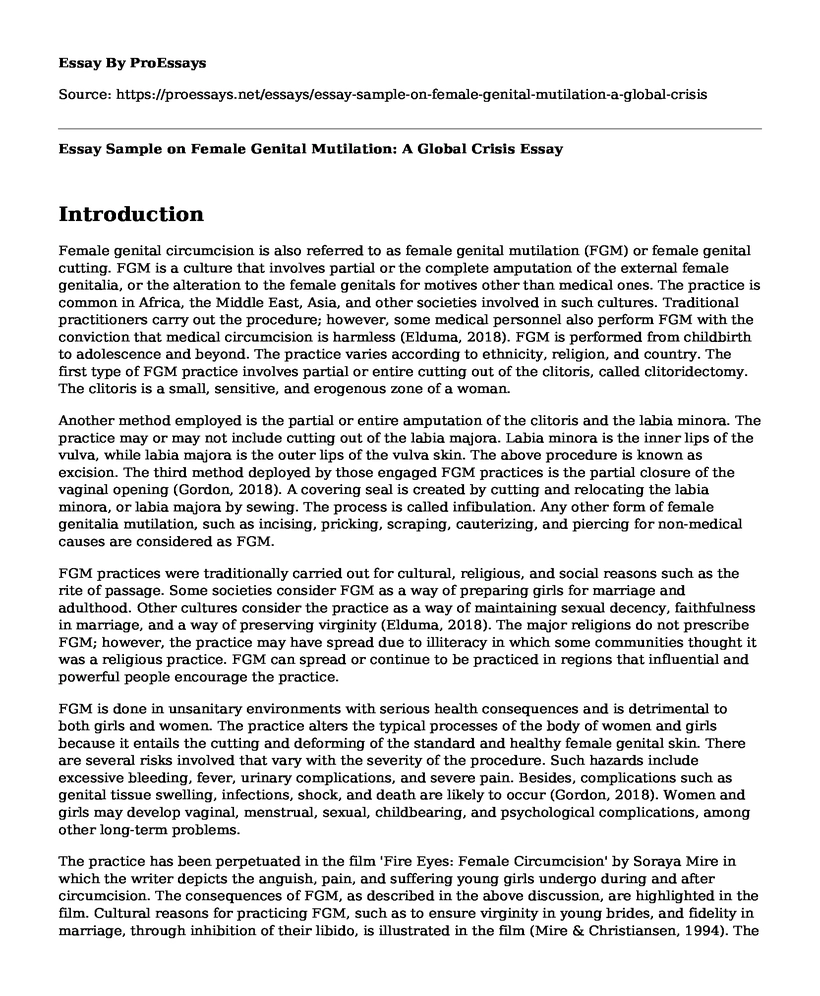Introduction
Female genital circumcision is also referred to as female genital mutilation (FGM) or female genital cutting. FGM is a culture that involves partial or the complete amputation of the external female genitalia, or the alteration to the female genitals for motives other than medical ones. The practice is common in Africa, the Middle East, Asia, and other societies involved in such cultures. Traditional practitioners carry out the procedure; however, some medical personnel also perform FGM with the conviction that medical circumcision is harmless (Elduma, 2018). FGM is performed from childbirth to adolescence and beyond. The practice varies according to ethnicity, religion, and country. The first type of FGM practice involves partial or entire cutting out of the clitoris, called clitoridectomy. The clitoris is a small, sensitive, and erogenous zone of a woman.
Another method employed is the partial or entire amputation of the clitoris and the labia minora. The practice may or may not include cutting out of the labia majora. Labia minora is the inner lips of the vulva, while labia majora is the outer lips of the vulva skin. The above procedure is known as excision. The third method deployed by those engaged FGM practices is the partial closure of the vaginal opening (Gordon, 2018). A covering seal is created by cutting and relocating the labia minora, or labia majora by sewing. The process is called infibulation. Any other form of female genitalia mutilation, such as incising, pricking, scraping, cauterizing, and piercing for non-medical causes are considered as FGM.
FGM practices were traditionally carried out for cultural, religious, and social reasons such as the rite of passage. Some societies consider FGM as a way of preparing girls for marriage and adulthood. Other cultures consider the practice as a way of maintaining sexual decency, faithfulness in marriage, and a way of preserving virginity (Elduma, 2018). The major religions do not prescribe FGM; however, the practice may have spread due to illiteracy in which some communities thought it was a religious practice. FGM can spread or continue to be practiced in regions that influential and powerful people encourage the practice.
FGM is done in unsanitary environments with serious health consequences and is detrimental to both girls and women. The practice alters the typical processes of the body of women and girls because it entails the cutting and deforming of the standard and healthy female genital skin. There are several risks involved that vary with the severity of the procedure. Such hazards include excessive bleeding, fever, urinary complications, and severe pain. Besides, complications such as genital tissue swelling, infections, shock, and death are likely to occur (Gordon, 2018). Women and girls may develop vaginal, menstrual, sexual, childbearing, and psychological complications, among other long-term problems.
The practice has been perpetuated in the film 'Fire Eyes: Female Circumcision' by Soraya Mire in which the writer depicts the anguish, pain, and suffering young girls undergo during and after circumcision. The consequences of FGM, as described in the above discussion, are highlighted in the film. Cultural reasons for practicing FGM, such as to ensure virginity in young brides, and fidelity in marriage, through inhibition of their libido, is illustrated in the film (Mire & Christiansen, 1994). The film also portrays how cultures like the Somali culture, FGM is deeply rooted, such that girls are not considered for marriage unless they undergo FGM.
The practice is a human rights concern since the method is a gender discrimination against women as it involves inequality between sexes. Besides, the practice is carried on minors, which constitutes a violation against the rights of children (Kopelman, 2018). FGM infringes people's rights to health, physical integrity, and security. The freedom from torture, maltreatment, and the right to life are violated through female genital circumcision when the procedure is fatal.
References
Elduma, A. H. (2018). Female genital mutilation in Sudan. Open access Macedonian journal of medical sciences, 6(2), 430. Retrieved from https://www.ncbi.nlm.nih.gov/pmc/articles/PMC5839462/
Gordon, J. S. (2018). Reconciling female genital circumcision with universal human rights. Developing world bioethics, 18(3), 222-232. Retrieved from https://onlinelibrary.wiley.com/doi/abs/10.1111/dewb.12173
Kopelman, L. M. (2018). Female Genital Circumcision and Conventionalist Ethical Relativism. In Globalizing Feminist Bioethics (pp. 219-237). Routledge. Retrieved from https://www.taylorfrancis.com/books/e/9780429500176/chapters/10.4324/9780429500176-16
Mire, S., & Christiansen, C. (1994). Fire Eyes. Female Circumcision. New York: Filmakers Library.
Cite this page
Essay Sample on Female Genital Mutilation: A Global Crisis. (2023, Mar 26). Retrieved from https://proessays.net/essays/essay-sample-on-female-genital-mutilation-a-global-crisis
If you are the original author of this essay and no longer wish to have it published on the ProEssays website, please click below to request its removal:
- Essay Example on Interconnectedness
- Essay on the Objectification of Women's Bodies
- Analysis of Caribbean Gender - Essay Sample
- Human Trafficking and Russian Mafia Paper Example
- The Problem of Discrimination Towards the Latino Community Inside the USA
- Essay Example on UC: A Premier Center of Learning & Research Since 1868
- Essay Example on Immigration in USA: Bich Nguyen's Story







